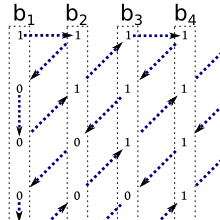Section 7: Problem 8 Solution
Working problems is a crucial part of learning mathematics. No one can learn topology merely by poring over the definitions, theorems, and examples that are worked out in the text. One must work part of it out for oneself. To provide that opportunity is the purpose of the exercises.
James R. Munkres
Let
denote the two-element set
; let
be the set of countable subsets of
. Show that
and
have the same cardinality.
Every countable subset
(i.e., every
) can be represented (not uniquely, but injectively) as a countable sequence
of its elements, i.e. as a countable sequence of countably infinite sequences of
’s and
’s:
. Hence,
can be represented (not uniquely, but injectively) as a countable table (with a countable number of columns equal to the number of elements in
, and countably infinite number of rows) by putting each
as column
of the table. If there are finite number of columns in the resulting table (a finite number of elements in
) then we add countably infinite number of columns having the same sequence
that does not belong to
. This way, as it is easy to see, we have constructed a unique countably infinite table for each countable set
(unique, because we can easily reconstruct set
given its table).
More formally, given a countable
, we would represent it as a sequence of its elements
, and map it to
such that, if
is no greater than the number of elements in
, then
, otherwise, when there are
elements in
and
, for
,
, and for
,
. Note that for
,
. It is easy to see that the mapping is injective.
In its turn, every countably infinite table can be injectively associated with a countable sequence of
’s and
’s. We can use a bijection
to define the
th element of the sequence as the element of the table having coordinates
. Then, different tables will map to different sequences.
Note again, that different countable sets
cannot be mapped to the same table, and different tables cannot correspond to the same final sequence of
’s and
’s. So, we have an injection one way.
Here is an example. Let
be the set of all sequences
. Since
is countable, it can be represented as a sequence of its elements (for example,
). This representation is not unique, but different
’s cannot have the same representation. Then, the infinite table (matrix) and the injection from the table to a sequence of
’s and
’s can be constructed, for example, as shown in Figure 1↓.
Vice versa, every sequence in
corresponds to a subset containing this one sequence only (singleton).
Having the two injections, we conclude, according to Exercise 6(b), that the two uncountable sets have the same cardinality.

